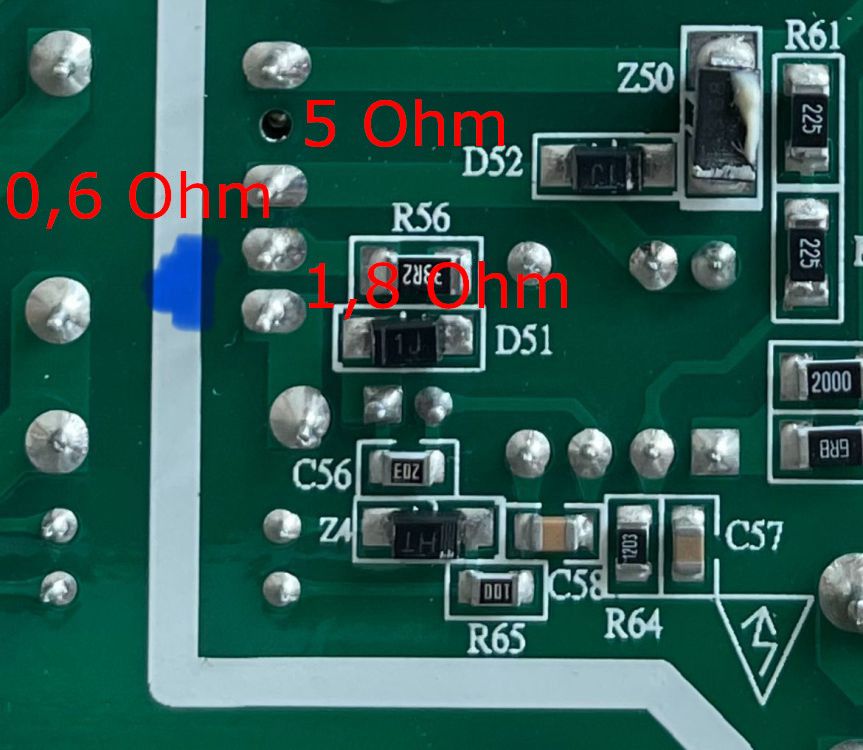-
Posts
8 -
Joined
-
Last visited
Content Type
Forums
Events
Gallery
Posts posted by Krisztoszteron
-
-
I could only find a through-hole technology (THT) resistor, so I tested it using that. However, the voltage remains high at the output, and the resistor that I replaced is getting warm. Therefore, I'm assuming that something else is also faulty, which likely caused the original 1k resistor to burn out.
My power supply is not identical to yours. Upon examining the images, I noticed that there are additional components on your board that are not present on mine, and vice versa. My stock four capacitors are rated for 63V and has a capacitance of 2200uF.
-
What value should I get at R20? (the component next to the three diodes).
The multimeter cannot read any resistance value and the top of the component is black, so I cannot read any information from that. -
7 hours ago, eduardofsjr said:
@Krisztoszteron, thanks for the information! Now I’m sure this transformer needs repair on my board.
About your case:There are few components on the left side of the board. Check diodes, resistors. What are DC voltages before transformer (right side)? I measured 330 V (be careful). AC input: 120V
You can disconnect audio board from PSU (5V, 15V+PSON, 62V). You should get only 5V on the left side, but the other side should work OK, except main transformer, because SSC9522S is off (no power on signal)
The diodes and resistors appear to be functioning properly. The diodes are not shorted and allow current to flow in only one direction. So i'm assuming, they are not faulty. The DC voltage on the high voltage side of the PCB is around 310V.
I could measure the voltage at the output by soldering in good capacitors, and plugging the PSU in only for a second. It was around 80V, so the high voltage was the reason why the capacitors blew up (they were rated only for 63V).
So I just need to find, what's the reason of that. Maybe the amp is damaged too because of the higher voltage... -
-
6 hours ago, eduardofsjr said:
@Krisztoszteron, did you get 0.2 ohms on those marked pins (picture that I posted) too? Transformer pins connected to ground and R56 resistor. I appreciate if you can measure it for me!
About the problem of your PSU, I suggest checking diodes, resistors, capacitors. Try to check and understand the “path” of current from transformers to output.I'll do that for you tomorrow. I hope we can get closer to the solution.
-
11 hours ago, eduardofsjr said:
Yes, the little transformer, for 5V, close to A6069H IC.
There is no continuity in this auxiliary coil.Primary coil: 5 ohms
Secondary coil: 0.2 ohms
I suppose this is the fault… No high Vcc, no power to main IC (controller of higher voltages)
The transformer has a code: 042-010317-001ZR
I could not find any specification to replace it. I’ll try to desolder and check the transformer.
The mentioned small transformer seems good to me.
I measure 5 and 0.2 ohms on it.
So, the problem is likely somewhere else. -
On 2/2/2024 at 1:48 PM, eduardofsjr said:
@DerHouy, thanks! Please share with us when you can.
I am still investigating this part of PSU.
I am getting 5V (V_out), but Vcc of A6069H is only 9.3V (maybe Vcc bias according to datasheet).
This Vcc feeds the main IC of PSU (15V and 62V) when you move the power switch to ON. But undervoltage of this main IC (SSC9522S) is 9.8 V. Thus, no power output.
Edit: Resistance at auxiliary winding D is huge (megaohms) and unstable. Did I find the problem?

Hi there!
I'm encountering a similar issue. I'm also facing a lack of both +15V and -62V. The 2200uF/63V capacitors have been blowing up one after another. Despite attempting replacements, one of them blew up again. Fortunately, I managed to disconnect the power cord in time to prevent further damage. I also replaced the rectifier connected to these capacitors, but the problem persists. The capacitors began heating up rapidly, prompting me to disconnect them immediately.
Regarding the "winding D" you mentioned, is it the separate coil located next to the transformer? I conducted measurements on it, and it appears to be functioning correctly.







R-110SW / R-112SW / R-115SW Repair Blog
in Technical/Restorations
Posted
Could you measure the optocoupler pins for me? I'm uncertain if there might be an issue, but my measurements seem to be incorrect. I'm obtaining the same value on the internal diode of the optocoupler when measured in reverse polarity as well.